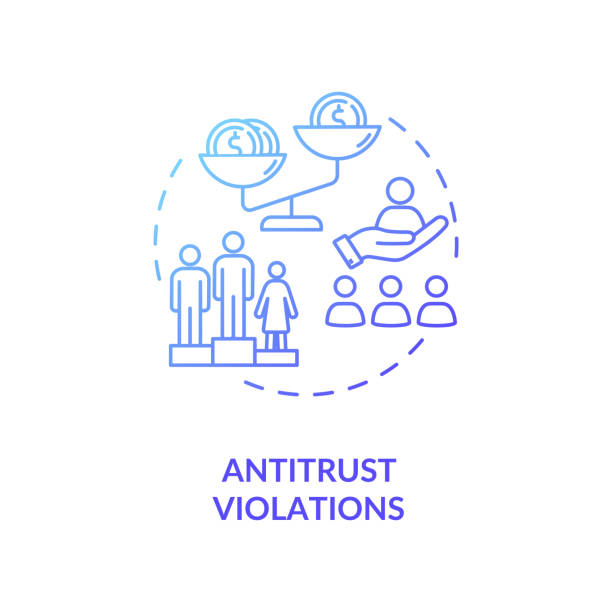ANTITRUST AND COMPETITION LAWS
By – Rishabh Tiwari, Barkatullah University, Bhopal, 3rd yr. B.A.LL.B
INTRODUCTION
Competition is the backbone of a successful economy, driving innovation, efficiency and consumer welfare. To ensure fair business practices and prevent monopolistic activity, governments around the world enact antitrust and competition laws. As a fast growing economy, India has also put in place a strong legal framework to promote competition and protect consumer interests. In today’s globalized and interconnected world, promoting fair competition is essential to foster innovation, protect consumers and ensure a level playing field for businesses. Antitrust and competition law play a key role in achieving these goals. This article discusses India’s antitrust and competition laws and examines the legal framework, enforcement mechanisms, notable cases and impact on the Indian economy.
LEGAL FRAMEWORK
The main objective of Antitrust and competition law is to prevent anti-competitive practices, promote market efficiency, protect consumer interests and promote economic growth. These laws aim to create a level playing field for all market participants by ensuring fair competition, preventing abuse of dominant positions and regulating mergers and acquisitions that may lead to anti-competitive effects.
Antitrust and competition laws in India are largely governed by the Competition Act, 2002 [1] which replaced the Monopolies and Restrictive Trade Practices Act, 1969 [2]. The purpose of the Competition Act is to prevent anti-competitive activities, promote market efficiency and protect the interests of consumers and consumers and small businesses. That Act established the Competition Commission of India (CCI) [3] as the regulatory body responsible for enforcement of competition laws.
The law prohibits four categories of anti-competitive activities: ·
- Anti-competitive agreements [4]:
The Competition Law prohibits agreements that harm competition, such as agreements that fix prices, limit production or supply, divide the market or disrupt. The law recognizes the negative impact of such agreements on competition and the economy as a whole. The CCI has the power to investigate and sanction companies that engage in such activities, which may include fines, suspension orders and other remedies. ·
- Abuse of a dominant position [5]:
The law also applies to abuse of a dominant market position. Current companies are prohibited from engaging in activities that may harm competition, such as predatory pricing, denying access to key functions or imposing unfair conditions on business partners. The CCI has the power to investigate allegations of abuse of a dominant position and impose sanctions to deter such activity.
- Mergers and acquisitions regulation [6]:
To ensure that mergers and acquisitions do not lead to a concentration of market power or harm competition, the Competition Act requires that certain transactions be notified to CCI for approval. The CCI assesses the likely impact of such transactions on competition and may approve them with or without modifications or in some cases prohibit them if they are found to be anti-competitive.
- Promotion of the competition:
In addition to enforcement measures, CCI also plays a key role in promoting competition. It conducts research, issues guidelines, and organizes information programs to educate stakeholders about the benefits of competition and the consequences of anticompetitive practices. CCI aims to promote a culture of compliance and encourage companies to voluntarily adopt fair practices.
Anti-competitive agreements include activities such as price fixing, bid rigging and market sharing. Dominant abuse refers to actions by a dominant company to suppress competition through practices such as predatory pricing, exclusive selling, and tying agreements. The Act also regulates combinations, including mergers, acquisitions and mergers, requiring companies to report transactions that meet certain thresholds to the CCI.
ENFORCEMENT MECHANISMS [7]
CCI has significant powers to enforce competition law in India. It has investigative and punitive functions to investigate complaints, initiate suo moto inquiries and impose penalties for violations. The CCI can impose a fine of up to three times the offending company’s profit or 10 percent of its turnover, whichever is greater.
The law also allows for penalty mitigation provisions that encourage companies to come forward and provide evidence of anti-competitive behaviour in exchange for reduced penalties. That provision encouraged the reporting of cartels and other anti-competitive agreements, which contributed to the CCI’s efforts to curb such practices.
The Act also empowers the CCI to issue winding-up orders to end anti-competitive practices and set aside orders in cases of abuse of dominant position. In addition, the CCI can prevent combinations that are likely to have an adverse effect on competition, thus helping to maintain a competitive market.
JUDGEMENTS
CCI has been actively involved in a number of important cases dealing with anti-competitive behaviour in various sectors of the Indian economy.
Telecommunications sector: In 2011, the CCI initiated an investigation into alleged anti-competitive practices by telecom operators. It found evidence of collusion between operators in setting call costs and imposing unfair conditions on subscribers. The investigation resulted in significant penalties for the companies involved and led to more transparent pricing and increased competition in the industry. [8]
Automobile industry: CCI has taken action against car manufacturers for practices such as limiting the supply of spare parts to independent repairers, imposing unfair terms on dealers and entering into anti-competitive agreements. The aim of such measures is to promote competition, ensure consumer choice and create more equal opportunities for smaller businesses. [9]
E-commerce sector: The CCI also investigated the e-commerce sector and investigated allegations of deep discounts, exclusive duties and preferential treatment of certain sellers. These investigations are focused on maintaining fair competition and protecting the interests of consumers and promoting a vibrant and competitive online market.[10]
IMPACT ON INDIAN ECONOMY
Promoting fair competition in the market promotes market efficiency and protects the interests of consumers. This in turn promotes economic growth and prosperity for all. Antitrust and competition laws have had a significant impact on the Indian economy by promoting fair competition, promoting market efficiency and protecting the interests of consumers.
- Impact on the business landscape:
India’s antitrust and competition laws have had a significant impact on the business world, fostering competition, promoting innovation and protecting consumer welfare. These laws have aligned for both established players and new entrants, fostering an environment that rewards efficiency and quality. Strict enforcement of these laws prevented anti-competitive practices, increased competition and improved consumer choice.
- Consumer benefits:
One of the main purposes of antitrust and competition law is to protect consumers from anti-competitive practices and to ensure that they have a wide range of choices at competitive prices. By preventing monopolistic behaviour and promoting competition, these laws led to improved product quality, lower prices and increased innovation. Consumers now have more choices and better value for money across sectors such as telecommunications, e-commerce and consumer goods.
- Market efficiency:
Antitrust and competition laws play a crucial role in promoting market efficiency. By preventing anti-competitive agreements and abuse of dominant positions, these laws encourage companies to compete on the basis of advantages, leading to efficient allocation of resources and improved productivity. The entry of new players into previously monopolized markets brought fresh ideas, technologies and business models that increased productivity and economic growth.
- Innovation and entrepreneurship:
a competitive market environment encourages innovation and entrepreneurship. Ensuring a level playing field, antitrust and antitrust laws encourage companies to invest in research and development, product differentiation and technological development. Start-ups and small businesses will also benefit from these laws as they will be able to compete with established players based on the quality of their innovative ideas and offerings.
- Foreign Investment:
Antitrust and competition laws play a crucial role in attracting foreign investment. A transparent and competitive market environment assures foreign investors that their investments are protected and that they can compete on a fair basis. This led to an increase in foreign direct investment (FDI) in India, which led to economic growth, job creation and technology transfer.
- Sectoral Reforms:
The implementation of antitrust and competition legislation has led to sector-specific reforms in various sectors. For example, in the pharmaceutical sector, CCI has taken steps against abuse of dominant position by pharmaceutical companies, which has resulted in cheaper availability of medicines. Similarly, CCI investigated anti-competitive practices in the real estate sector, leading to increased transparency, fairer pricing and improved consumer protection.
CONCLUSION
India’s antitrust and competition laws have played an important role in promoting fair competition, protecting consumer interests and promoting market efficiency. The Competition Act, coupled with CCI’s active enforcement, has resulted in improved consumer choice, lower prices, increased innovation and sector-specific reforms. However, there is still room for improvement in the implementation of these laws, especially in dealing with complex issues such as digital monopolies and the intersection of intellectual property rights and competition law. Continued efforts to strengthen and improve antitrust and competition laws in India will contribute to a vibrant and competitive market environment that will foster economic growth and benefit both businesses and consumers.
[1] Act Number 12 of 2003 (13th January, 2003).
[2] Act Number 54 of 1969.
[3] Chapter III of The Competition Act, 2000.
[4] Section 3 of The Competition Act, 2000.
[5] Section 4 of The Competition Act, 2000.
[6] Section 5-6 of The Competition Act, 2000.
[7] Chapter 4 “Duties, Powers & Functions of the Commission” of The Competition Act, 2000.
[8] “2011 revisited- Telecom shines despite controversies” (Business Standard, https://www.google.com/amp/s/wap.business-standard.com/article-amp/economy-policy/2011-revisited-telecom-shines-despite-controversies-111123000097_1.html, January 20, 2013) accessed April 27, 2023.
[9] Shri Shamsher Kataria V/S Honda Siel Cars India Ltd & Ors (2014, Case no. 03/2011, Competition Commission of India)
[10] Delhi Vyapar Mahasangh V/S Flipkart Internet Private Limited & Anr. (Case no. 40 of 2019, Competition Commission of India)










